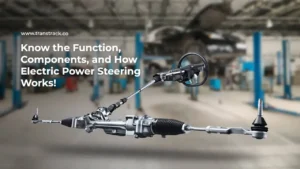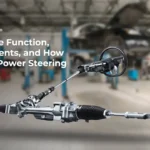Learn the 5 Steps to Starting a Heavy Equipment Rental Business and its Challenges!
Posted on July 8, 2024 by Nur Wachda Mihmidati

The heavy equipment rental business is a crucial sector in infrastructure development, construction, mining and agriculture. Heavy equipment such as bulldozers, excavators, and cranes are the backbone of various large projects that support the economic growth and progress of a country. However, starting and managing a heavy equipment rental business is not an easy task. Many aspects need to be considered, from market research, business planning, to efficient fleet management. This TransTRACK article will discuss the steps to starting a heavy equipment business, the challenges you may face, and solutions that can help you optimize your operations and increase profitability.
Benefits of Owning a Heavy Equipment Rental Business
Owning a heavy equipment business offers a variety of benefits that can increase long-term stability and success. Here are some of the key benefits:
High Demand
The demand for heavy equipment continues to increase as the construction and infrastructure sectors grow. Road construction projects, buildings, and public facilities require various types of heavy equipment for work efficiency. Mining and agricultural industries also require heavy equipment for their daily operations.
Financial Benefits
The heavy equipment business offers significant financial profit opportunities due to its high resale value and rental rates. Heavy equipment rental provides stable recurring income, especially with long-term contracts. With the right strategy, this business can generate consistent profits.
Service Diversification
The heavy equipment business is not only limited to sales, but also rental and maintenance services. Providing repair services and spare parts can be an additional source of revenue. Diversifying these services helps to fulfill various customer needs and increase their loyalty.
Steps to Start a Heavy Equipment Rental Business
There are several steps you can take when you want to start a heavy equipment business. Here are the steps:
Market Research
The first step in starting a heavy equipment business is to conduct thorough market research. This involves analyzing the demand for heavy equipment in the target area, identifying competitors, and understanding the needs and preferences of potential customers. Good market research will provide insights into the opportunities and challenges that may be faced, which can help in designing an effective business strategy.
Business Planning
After conducting market research, the next step is to develop a detailed business plan. This plan should include the vision, mission and goals of the business, as well as strategies to achieve these goals. In addition, the business plan should also include financial analysis, marketing strategies, and a clear operational plan to ensure the business runs smoothly.
Start-up Capital and Financing
Starting a heavy equipment business requires significant start-up capital for the purchase or lease of heavy equipment as well as initial operational costs. Identifying sources of funding, such as personal savings, bank loans or investors, is essential. In addition, it is important to have a sound financial plan to ensure healthy cash flow and anticipate future funding needs.
Purchase or Lease Heavy Equipment
Once capital is available, the next step is to decide whether to buy or rent heavy equipment. This decision depends on a cost and benefit analysis, as well as the long-term needs of the business. Purchasing a machine provides full ownership, while leasing can reduce initial costs and provide flexibility.
Licenses and Regulations
Starting a heavy equipment business also requires compliance with various applicable licenses and regulations. This includes obtaining business permits, operating licenses, and meeting safety and environmental standards set by the government. Ensuring all legal requirements are met will help avoid problems later on and lend legitimacy to the business.
What are the Challenges in the Heavy Equipment Rental Business?
Here are some of the challenges in the heavy equipment business, as well as solutions to overcome them:
High Maintenance Costs
Heavy equipment requires regular maintenance and repairs that often come at a significant cost. Without adequate maintenance, machines can break down more frequently, resulting in costly downtime. TransTRACK’s Fleet Management System helps address this issue by providing real-time monitoring of machine conditions, so preventive maintenance can be performed in a timely manner to reduce repair costs and increase machine lifespan.
Complex Fleet Management
Managing multiple machines spread across different project sites is a major logistical challenge. Without proper coordination, inefficiencies and reduced productivity can result. TransTRACK’s Fleet Management System enables efficient monitoring and management of fleets from one integrated platform. This helps improve operational coordination and productivity by ensuring that each machine is utilized optimally and on time.
Difficulties in Tracking Usage and Performance
Tracking the usage and performance of each machine is a challenging task, especially in large projects with multiple machines. Without accurate data, it is difficult to optimize machine usage and identify performance issues. With TransTRACK, users can access detailed, real-time machine usage and performance data. This enables better analysis for more informed decision-making, thus improving operational efficiency and productivity.
Machine Security and Theft
Heavy equipment is often the target of theft, which can cause huge financial losses. In addition, the safety of operators and machines must also be guaranteed. TransTRACK’s Fleet Management System is equipped with a GPS tracking feature that enables real-time monitoring of machine location, reducing the risk of theft. The system can also monitor operator behavior to improve operational safety, ensuring that machines are used in accordance with established safety standards.
Market Demand Fluctuations
Demand for heavy equipment can fluctuate depending on economic conditions and available projects, which can affect business revenue. With the data obtained from TransTRACK, businesses can conduct better market analysis and plan more flexible strategies to deal with demand fluctuations. Real-time information on machine usage and performance helps companies adapt their operations to changes in market demand, thereby optimizing revenue and cost efficiency.
Integrating TransTRACK’s Fleet Management System on leased or purchased machines not only helps overcome these challenges but also improves overall business efficiency and profitability.
Managing a heavy equipment business is full of challenges, ranging from high maintenance costs, complex fleet management, to fluctuations in market demand. However, with the right strategy and technological assistance, this business can be highly profitable. TransTRACK’s Fleet Management System offers a comprehensive solution to address these challenges. With real-time monitoring, performance analysis, and advanced security features, TransTRACK can help you optimize your operations, reduce costs, and improve the efficiency of your heavy equipment business.
Don’t let challenges hinder your business growth. Integrate TransTRACK’s Fleet Management System now and experience the transformation in your heavy equipment fleet management!
Recent Post
Know the Function, Components, and How Electric Power Steering Works!
December 24, 2025Know the Types of Buses Based on Their Model, Size, and Capacity!
December 22, 2025Topic :
Recommended Articles

 Bahasa Indonesia
Bahasa Indonesia








